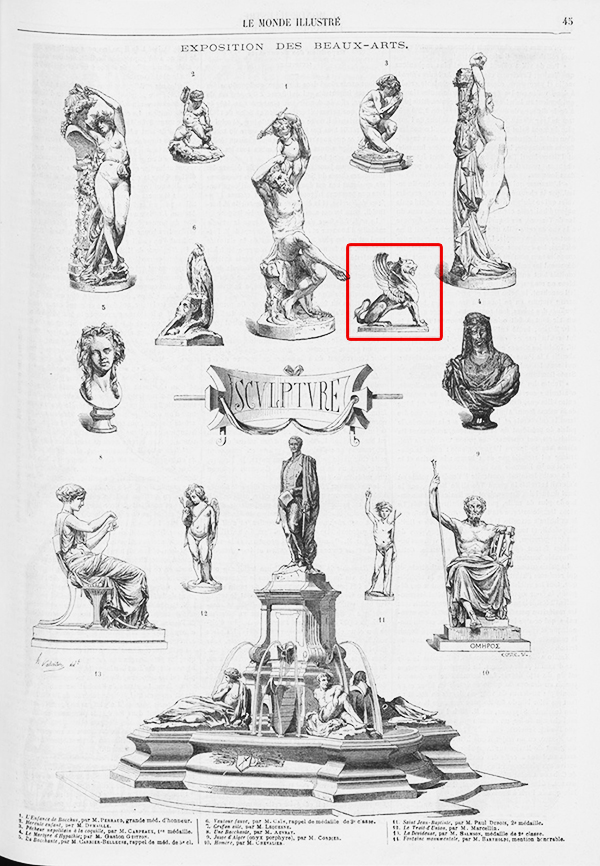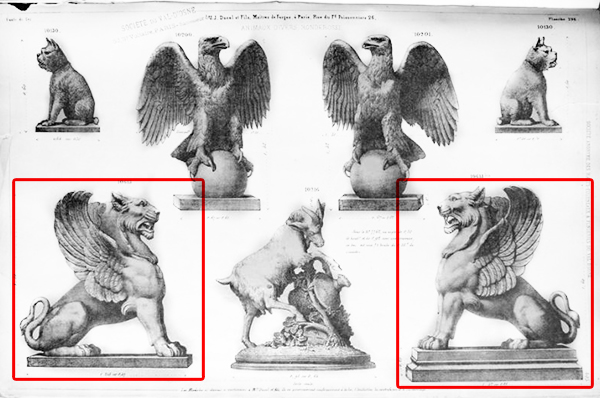Style Napoleon III / Ref.12723
Rare pair of winged lions, cast iron, 19th century
Dimensions
Width 19'' ¼ 49cm
Height 35'' 89cm
Depth: 34'' ⅝ 88cm
Origin:
19th century.
Status:
Good condition.
Although called "griffins" by the artist and in the foundry's catalogue, they are rather a pair of winged lions, as evidenced by the absence of bird beaks, in cast iron and made by the Ducel or Val d'Osne foundry at the end of the 19th century after a model by Eugène-Louis Lequesne.

Initially designed to be part of the decoration of the current Musée de Picardie in Amiens as part of the project for the exterior and interior decoration of the museum by the architect Arthur Diet, these two winged lions, known as "griffins", were commissioned in 1861 by Diet to the sculptor Eugène-Louis Lequesne. In a letter from the architect dated 31 December 1861 addressed to a commission, Diet specified that E. Lequesne: "will make a sketch of them but on condition that these animals (be made) after the antique. If we wanted animals copied from nature, he would not interfere". On 8 February 1861, Lequesne submitted his model, which he exhibits at the 1863 Salon. These "griffins" were drawn by Lequesne after the antique and were included in the catalogue of the Ducel or Val d'Osne foundry at the end of the 19th century. Very popular, this model was delivered in several countries as orders for monuments or outdoor decorations were received.
This model can be found in two of the foundry's catalogues :

Eugène-Louis Lequesne (1815-1887) was a French sculptor, student of James Pradier, he exhibited his work at the Salon from 1842. He was awarded of the First Prize of Rome in 1844 and had already won second place in 1843. Brilliant sculptor, he was nominated as knight of the Legion of Honour in 1855 and regularly exhibited his work at the Salon, including the model for our sculptures. Many of his works, including the famous "Dancing Faun", adorn public spaces.
The figure of the winged lion dates back to the ancient period. This period provided famous examples such as the "Winged Lion of Vulci" from the Etruscan civilisation. In the ancient Greco-Roman world, from which the models that inspired Lequesne were made, artistic representations of the lion were very frequently associated with the figure of the guardian, both of the world of the living and dead.
This pair of winged lions is associated with the 19th century taste for both Antiquity and representations of the fantastic. Other sculptors of Lequesne's time produced similar sculptures, such as the chimeras of Henri-Alfred Jacquemart or the statue of the winged lion by Auguste-Nicolas Cain.
Comparison work :

Other international exemple of « griffins » by Val d’Osne foundry :

Informations
Price: on request
Recommended for you :
Dimensions:
Width: 64
Height: 274
Depth: 64
Dimensions:
Width: 66
Height: 161
Depth: 50
Diameter: 50
Dimensions:
Width: 30
Height: 126
Depth: 74
Dimensions:
Height: 128
Depth: 79
Diameter: 55
Dimensions:
Height: 238
Diameter: 75
Dimensions:
Height: 265
Diameter: 100
Dimensions:
Width: 107
Height: 224
Depth: 121
Dimensions:
Width: 56
Height: 118
Dimensions:
Width: 60
Height: 172
Depth: 57
Dimensions:
Width: 36
Height: 56
Depth: 36
Dimensions:
Width: 57
Height: 80
Depth: 28
Dimensions:
Height: 212

























